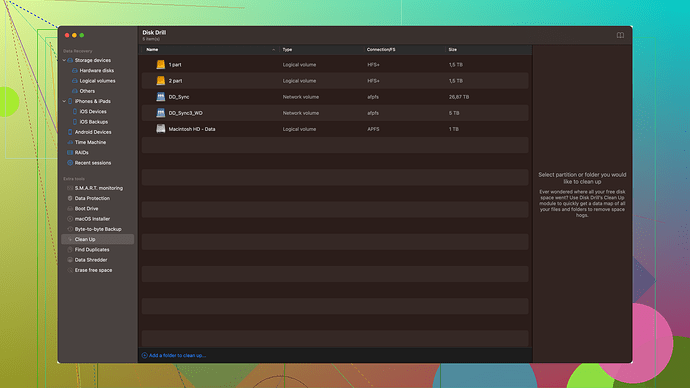Hey everyone, I accidentally deleted important files from my SD card while using my Mac. Does anyone know a free way to recover the data? I really need those files back ASAP. Any advice or recommendations would be greatly appreciated. Thanks!
If you deleted important files from your SD card, don’t panic! There are actually a few ways you can recover them for free on your Mac.
First, check the Trash. Sometimes, deleting files on an external storage device might move them to the Trash. If they’re not there, open up the Terminal and try using the undelete command, though it’s not guaranteed to be foolproof.
But if you’re looking for a more user-friendly option, consider Disk Drill. It’s a data recovery software that’s highly recommended for such cases. Disk Drill offers a free version that can scan and recover files up to a certain limit, which could be enough to retrieve your important data. The interface is pretty straightforward, so it’s beginner-friendly. Check out this Independent Disk Drill Review for more details.
Remember, avoid using the SD card until you try these steps to improve your chances of successful recovery. Good luck!
Losing data from an SD card can be a major headache, but don’t worry, there are a few free methods you can try to recover your files on a Mac. Here’s what you can do:
Step-by-Step Guide:
-
Check Trash Bin: When you delete files on a Mac, they often end up in the Trash before they are permanently removed. Open the Trash and see if your files are there.
-
Data Recovery Software:
- Disk Drill: One of the most popular and reliable free recovery tools for Mac. It’s known for its simple UI and effectiveness in data recovery. You can download it here: Disk Drill for Mac.
-
Use Disk Drill:
- Install Disk Drill: After downloading, install Disk Drill on your Mac.
- Run Disk Drill: Open the software, you’ll see an option to recover data. Select your SD card from the list of storage devices.
- Scan SD Card: Initiate a scan. Disk Drill will search for lost files.
- Preview and Recover: Once the scan completes, it will list the recoverable files. Preview them to make sure they are correct and choose which ones you need to recover.
-
Mac’s Built-in Options:
- Time Machine Backup: If you’ve been using Time Machine to back up your Mac, you might be able to recover the files from a previous backup. Open Time Machine and navigate to the date/time when the files were intact.
- Terminal Command: For advanced users, using Terminal commands like
diskutilto repair the SD card may also help in some cases. Remember that this requires some knowledge of command-line operations.
DIY Enthusiast Approach:
- Try Reconstruction with BBEdit: If you have some technical knowledge, use a hex editor like BBEdit to identify and manually reconstruct the deleted files. This can be extremely tedious and isn’t guaranteed to work unless you know exactly what you’re doing.
Important Tips:
- Avoid Writing to the SD Card: As soon as you realize files are deleted, avoid writing new data to the SD card. It minimizes the risk of overwriting the deleted files.
- Backup Regularly: This is more of a preventive measure, but always keep copies of important data in multiple locations.
Technical Jargon:
Utilizing sophisticated algorithms, Disk Drill leverages deep scan capabilities to analyze and identify lost data segments. This tool enhances the probability of successful data retrieval by recognizing file signatures extensive to both HFS, HFS+, and even exFAT file systems. These functionalities render it exceptionally apt for various recovery scenarios that might involve logical data fragmentation or inadvertent file system deletions.
Before trying manual recovery, it’s always safer to use specialized software like Disk Drill due to its comprehensive scanning and recovery options. The free trial version often allows you to recover a limited amount of data, which might be sufficient depending on how much you lost.
Anyway, try the steps above and cross your fingers! Hope you get your files back ASAP.
Recovering deleted files from an SD card on a Mac for free? Good luck with that. Free recovery software usually has limitations. You’ll either get a watered-down version or hit a paywall midway.
Disk Drill for Mac comes recommended often. Pros: It’s reliable, works with various types of storage, and has a user-friendly interface. Cons: The free version has serious restrictions. Good luck restoring important files without paying eventually.
Check out this article for more insights on different options: Top 10 Best Data Recovery Software for Mac (Including FREE). But keep your insurance money handy, since truly free solutions are almost non-existent if your data’s that critical.
Ugh, I feel your pain. Losing important files is the worst. So, here’s the thing, for free options, your choices are kinda limited. You can try using macOS’s built-in Time Machine if you had it set up before. As for software, there’s Disk Drill for Mac. It’s popular, but the free version is super limited—they only let you see what you can recover without actually recovering it. It’s like teasing you with your lost files. Worth a shot, but manage your expectations. Kinda sucks not having more free solutions, tbh. Good luck!
